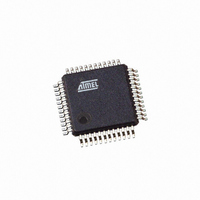AT43USB326-AU Atmel, AT43USB326-AU Datasheet - Page 17

AT43USB326-AU
Manufacturer Part Number
AT43USB326-AU
Description
IC USB KEYBOARD CTRLR 48LQFP
Manufacturer
Atmel
Series
AVR®r
Datasheet
1.AT43USB326-AC.pdf
(102 pages)
Specifications of AT43USB326-AU
Applications
Keyboard Controller
Core Processor
AVR
Program Memory Type
Mask ROM (16 kB)
Controller Series
AT43USB
Ram Size
512 x 8
Interface
USB
Number Of I /o
32
Voltage - Supply
4.4 V ~ 5.25 V
Operating Temperature
-40°C ~ 85°C
Mounting Type
Surface Mount
Package / Case
48-LQFP
Lead Free Status / RoHS Status
Lead free / RoHS Compliant
Available stocks
Company
Part Number
Manufacturer
Quantity
Price
Functional
Description
On-chip Power
Supply
I/O Pin
Characteristics
Oscillator and PLL
3313D–USB–04/06
The AT43USB326 contains two on-chip power supplies that generate 3.3V with a capacity of
30 mA each from the 5V power input. The on-chip power supplies are intended to supply the
AT43USB326 internal circuit and the 1.5K pull-up resistor only and should not be used for
other purposes. External 2.2 µF filter capacitors are required at the power supply outputs,
CEXT1 and CEXT2. The internal power supplies can be disabled as described in the next
paragraph.
The user should be careful when the GPIO pins are required to supply high-load currents. If
the application requires that the GPIO supply currents beyond the capability of the on-chip
power supply, the AT43USB326 should be supplied by an external 3.3V power supply. In this
case, the 5V V
the chip through the CEXT1 and CEXT2 pins.
The I/O pins of the AT43USB326 should not be directly connected to voltages less than V
more than the voltage at the CEXT pins. If it is necessary to violate this rule, insert a series
resistor between the I/O pin and the source of the external signal source that limits the current
into the I/O pin to less than 2 mA. Under no circumstance should the external voltage exceed
5.5V. To do so will put the chip under excessive stress.
All clock signals required to operate the AT43USB326 are derived from an on-chip oscillator.
To reduce EMI and power dissipation, the oscillator is designed to operate with a 6 MHz crys-
tal. An on-chip PLL generates the high frequency for the clock/data separator of the Serial
Interface Engine. In the suspended state, the oscillator circuitry is turned off.
The oscillator of the AT43USB326 is a special, low-drive type, designed to work with most
crystals without any external components. The crystal must be of the parallel resonance type
requiring a load capacitance of about 10 pF. If the crystal requires a higher value capacitance,
external capacitors can be added to the two terminals of the crystal and ground to meet the
required value. To assure quick start-up, a crystal with a high Q, or low ESR, should be used.
To meet the USB hub frequency accuracy and stability requirements for hubs, the crystal
should have an accuracy and stability of better than 100 PPM. The use of a ceramic resonator
in place of the crystal is not recommended because a resonator would not have the necessary
frequency accuracy and stability.
The clock can also be externally sourced. In this case, connect the clock source to the XTAL1
pin, while leaving XTAL2 pin floating. The switching level at the OSC1 pin can be as low as
0.47V and a CMOS device is required to drive this pin to maintain good noise margins at the
low switching level.
For proper operation of the PLL, an external RC filter consisting of a series RC network of
100Ω and 0.1 µF in parallel with a 0.01 µF capacitor must be connected from the LFT pin to
V
SS
. Use only high-quality ceramic capacitors.
CC
power supply pin should be left unconnected and the 3.3V power supplied to
AT43USB326
SS
17
or













